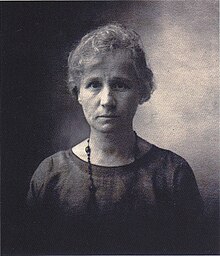Blanche Lazzell
| Blanche Lazzell | |
|---|---|

Lazzell in Manhattan, circa 1908
|
|
| Born |
Nettie Blanche Lazzell October 10, 1878 Monongalia County, West Virginia |
| Died | June 1, 1956 (aged 77) Bourne, Massachusetts |
| Nationality | American |
| Known for | Printmaking, painting, etching |
| Notable work | The Monongahela (1926) |
| Movement | Modernism |
Blanche Lazzell (October 10, 1878 – June 1, 1956) was an American painter, printmaker and designer. Known especially for her white-line woodcuts, she was an early modernist American artist, bringing elements of Cubism and abstraction into her art.
Born in a small farming community in West Virginia, Lazzell traveled to Europe twice, studying in Paris with French artists Albert Gleizes, Fernand Léger, and André Lhote. In 1915, she began spending her summers in the Cape Cod art community of Provincetown, Massachusetts and eventually settled there permanently. She was one of the founding members of the Provincetown Printers, a group of artists who experimented with a white-line woodcut technique based on the Japanese ukiyo-e woodblock prints.
Nettie Blanche Lazzell was born October 10, 1878 on a farm near Maidsville, West Virginia to Mary Prudence Pope and Cornelius Carhart Lazzell. Her father was a direct descendant of Reverend Thomas and Hannah Lazzell, pioneers who settled in Monongalia County after the American Revolutionary War. The Lazzells were devout Methodists, attending the Bethel Methodist Episcopal Church. The ninth of ten children, she was nicknamed "Pet" by her older brother Rufus, a name that her family would continue to use throughout her life. She grew up on the 200 acre (0.81 km2) family farm, attending a one-room schoolhouse on the property where students from the first through eighth grades were taught from October through February. Her mother died when she was twelve.
When Lazzell was fifteen, she enrolled in the West Virginia Conference Seminary (now West Virginia Wesleyan College) in Buckhannon. Probably sometime prior to her entering the Seminary she became partially deaf, although the exact origin of her condition is unclear. In 1894 she sought treatment from a Baltimore doctor who blamed her deafness on catarrh.
...
Wikipedia
